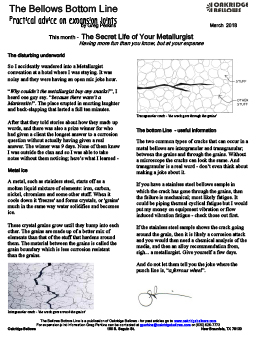Metallurgy Of Metal Bellows Failures

The Secret Life of Your Metallurgist
Having more fun than you know, but at your expense
The disturbing underworld
So I accidently wandered into a Metallurgist convention at a hotel where I was staying. It was noisy and they were having an open mic joke hour. “Why couldn’t the metallurgist buy any snacks?”, I heard one guy say. “because there wasn’t a Martensite!”. The place erupted in snorting laughter and back-slapping that lasted a full ten minutes. After that they told stories about how they made up words, and there was also a prize winner for who had given a client the longest answer to a corrosion question without actually having given a real answer. The winner was 9 days. None of them knew I was outside the clan and so I was able to take notes without them noticing; here’s what I learned – Metal ice A metal, such as stainless steel, starts off as a molten liquid mixture of elements: iron, carbon, nickel, chromium and some other stuff. When it cools down it ‘freezes’ and forms crystals, or ‘grains’ much in the same way water solidifies and becomes
ice.
These crystal grains grow until they bump into each other. The grains are made up of a better mix of elements than that of the stuff that hardens around them. The material between the grains is called the grain boundary which is less corrosion resistant than the grains.
Intergranular crack – ‘the crack goes around the grains’
The bottom Line – useful information
The two common types of cracks that can occur in a metal bellows are intergranular and transgranular; between the grains and through the grains. Without
a microscope the cracks can look the same. And transgranular is a real word – don’t even think about making a joke about it.
If you have a stainless steel bellows sample in which the crack has gone through the grains, then the failure is mechanical; most likely fatigue. It could be piping thermal cyclical fatigue but I would put my money on equipment vibration or flow induced vibration fatigue – check those out first.
If the stainless steel sample shows the crack going around the grain, then it is likely a corrosion attack and you would then need a chemical analysis of the media, and then an alloy recommendation from, sigh… a metallurgist. Give yourself a few days.
And do not let them tell you the joke where the punch line is, “a ferrous wheel”.


